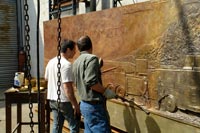 |
The central element of the Memorial environment is the permanent bronze wall that captures the sacrifice of the men and women of the Fire Department of the City New York (FDNY) in responding to the challenge of the World Trade Towers’ attack and subsequent collapse. The FDNY Memorial Wall is an artistic composition depicting the equipment, apparatus and tactics used in battling this tragic event.
It is not intended to be an exact replication. It is, however, meant to be inclusive, representing each group, tool and type of vehicle present that day. |

 |
sketches
On December 18, 2003, Joseph Oddi extracted a rough design sketch of the Memorial from initial conversations held in meetings with a core group of representatives from the FDNY and Holland + Knight LLP, to discuss the initial Rambusch design concept, conceived by Viggo Bech Rambusch, modeled on Trajan’s Column. Over the subsequent months, this initial sketch was critiqued, refined, reviewed and translated into detailed scaled drawings. |
 |

 |
the plastiline model
Plastiline is an oil-based modeling clay that remains workable for long periods without shrinking. Bringing them to life in three-dimensional form, Joseph Petrovics created the full-size model of the Memorial. Over the course of many months, the developing sculpture was reviewed and refined under the stewardship of the FDNY. |

 |
casting
After taking a plaster negative from the completed plastiline work, the Bedi-Makky Art Foundry then transferred this to a plaster positive and finally pressed this into sand, creating the negative mold. This void was filled with more than two tons of molten bronze. The company poured and finished all fourteen panels in this manner at their facility in Brooklyn, NY. |

 |
brazing into one
The completed wall is 56-feet long by 6-feet high. It is composed of three main sections—two 24-foot panels north and south, joined by an 8-foot long center unit. The north and south panels depict movement of men and equipment toward the ailing towers.
The center area dominates with the towers themselves. The long sections were built by brazing six smaller castings together. Two castings form the center section, totaling fourteen castings in all to complete the installation. Beneath the relief is the names of the lost listed by rank, alphabetically, Engraved into the finished work. |

 |
final finishing
This bronze casting was thoroughly wire-brushed to a perfect smoothness. While heating the metal, a variety of chemicals such as ferric nitrate, sulphurated potash and other acids were applied to modify and enhance its finish. A protective application of sacrificial wax completed the metalwork, preserving its patinated finish. |

 |
lighting bas-relief
Bas-relief, by nature, is a three-dimensional medium. Mounted at a high incident angle, wallwashing units were planned early on to more effectively render the relief sculpture. Accenting units were incorporated to highlight the roster of fallen firefighters. |
|
|


